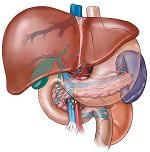Article
Hyponatremia Produces Poor Outcomes in Acute-on-Chronic Liver Failure
Author(s):
Drawing upon data from a large European study, Andrés Cárdenas, MD, reported an association between hyponatremia and acute-on-chronic liver failure (ACLF) during a poster session at the 2013 annual meeting of the American Association for the Study of Liver Diseases held November 1-5, 2013, in Washington, DC.

Drawing upon data from a large European study, Andrés Cárdenas, MD, reported an association between hyponatremia and acute-on-chronic liver failure (ACLF) during a poster session at the 2013 annual meeting of the American Association for the Study of Liver Diseases held November 1-5, 2013, in Washington, DC.
Cirrhosis patients who experience ACLF may face poor short-term survival. The condition is characterized by a systemic inflammatory response, with acute decompensation and organ failure.
For their poster, Cárdenas and colleagues from the Institute of Digestive Diseases and Metabolism at the Hospital Clinic and University of Barcelona examined data from the CLIF Acute-on-Chronic Liver Failure in Cirrhosis Study (CANONIC) to determine whether hyponatremia has prognostic value in cirrhotic patients with and without ACLF.
The CLIF CANONIC database included the health records of 1,341 consecutive patients at 29 different European centers who presented with acute decompensation of cirrhosis of the liver.
Of the 517 patients with acute compensation of cirrhosis available for the study’s 28-day follow-up period, 217 (42.0%) had ACLF at enrollment, while 300 (58.0%) were free of ACLF when they enrolled. Of the group with ACLF, 48 (22.1%) had hyponatremia, which was defined as serum sodium <130meq/L. No hyponatremia was seen in 179 (78.9%) of the ACLF patients.
More than half (58%) of the 300 enrollees showed no signs of ACLF, and just 34 (11.3%) of those patients experienced hyponatremia. The remaining 266 (88.7%) were not hyponatremic.
Kaplan-Meier survival curves were calculated out to 90 days from enrollment for in all 4 subgroups. Stratification according to ACLF status and sodium levels showed that the survival probability for transplant-free individuals was highest among those with neither ACLF nor hyponatremia, at 88.9%. Hyponatremia subjects without ACLF had a 70.5% survival probability at 90 days post-enrollment. For patients with ACLF but no hyponatremia at enrollment, 90-day survival probability was 58.7%. Finally, the lowest 90-day survival probability was seen in those with ACLF who were also hyponatremic at enrollment, at just 35.8%.
Multivariate analysis of the results showed both ACLF and leukocyte count to be risk factors for hyponatremia independently of each other. Hyponatremia served as a prognostic indicator both in patients with and without ACLF, and hyponatremia in ACLF had a strongly significant association with 90-day mortality.
Therefore, the researchers concluded that hyponatremia alone is not a poor prognostic factor for individuals with decompensation and cirrhosis; however, in the presence of ACLF and decompensation, hyponatremia is a poor prognostic factor for individuals with cirrhosis.





